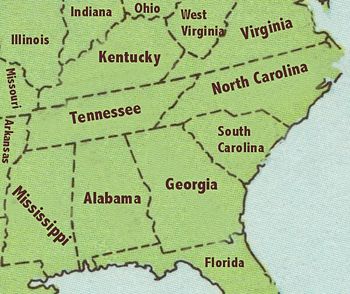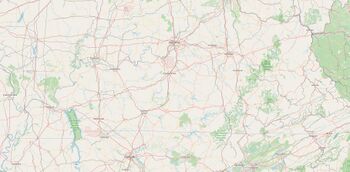Kentucky (U.S. state): Difference between revisions
Pat Palmer (talk | contribs) m (Text replacement - "Tennessee" to "Tennessee (U.S. state)") |
Pat Palmer (talk | contribs) m (Text replacement - "Missouri (U.S. state)|Missouri" to "Missouri") |
||
| (22 intermediate revisions by 2 users not shown) | |||
| Line 1: | Line 1: | ||
{{subpages}} | {{subpages}} | ||
{{Image|SE USA.jpg|right|350px|}} | {{dambigbox|Kentucky (U.S. state)|Kentucky}} | ||
'''Kentucky''', officially the ''Commonwealth of Kentucky'', is a state in the [[United States of America]]. In 1792, Kentucky became the fifteenth state to join the U.S. | {{Image|SE USA.jpg|right|350px|Location of Kentucky relative to other states.}} | ||
{{Image|Map of Kentucky.jpg|right|350px|Open Street Map view of Kentucky, showing relative locations of cities.}} | |||
'''Kentucky''', officially the ''Commonwealth of Kentucky'', is a state in the [[United States of America|U.S.]]. In 1792, Kentucky became the fifteenth state to join the U.S. The state capital is [[Frankfort, Kentucky|Frankfort]]. | |||
In the [[American Civil War]] of 1861–1865, Kentucky's elected government did not | In the [[American Civil War]] of 1861–1865, Kentucky's elected government did not secede from the union, but it almost could have, as the state was highly divided between unionists and secessionists. At the outset of the war, the Kentucky state legislature declared the state to be neutral, but confederate forces invaded the state early on and attempted to hold certain locations along the Mississippi and Ohio rivers, angering the legislature. This allowed the union to come in and take those areas back, thus narrowly averting the possibility that Kentucky would vote to secede from the union. Despite officially remaining in the union during the war, Kentucky had a "rump government", an unelected group that proclaimed secession in 1861<ref>The text of [http://gen.1starnet.com/civilwar/kyord.htm Kentucky's Ordinance of Secession].</ref> and was accepted into the [[Confederate States of America]], while the United States continued to claim Kentucky as its own. At the time, Kentucky allowed slavery and had both Unionist and Confederate counties, including some Unionist slave-owners. | ||
Rivers define Kentucky's borders except on the south, where it has a straight line border with [[Tennessee (U.S. state)]] and on its mountainous southeastern border with [[Virginia]]. The [[Tug river]] and [[Big Sandy river]] separate it from [[West Virginia]] on the east and northeast. The northern border follows the [[Ohio river]] and separates Kentucky from the states of [[Ohio]], [[Indiana]], and [[Illinois]]. Where the Ohio river flows into the Mississippi, the short western border with [[Missouri]] is formed by the [[Mississippi]]. The capital, [[Frankfort | Rivers define Kentucky's borders except on the south, where it has a straight line border with [[Tennessee (U.S. state)|Tennessee]] and on its mountainous southeastern border with [[Virginia (U.S. state)|Virginia]]. The [[Tug river]] and [[Big Sandy river]] separate it from [[West Virginia (U.S. state)|West Virginia]] on the east and northeast. The northern border follows the [[Ohio river]] and separates Kentucky from the states of [[Ohio (U.S. state)|Ohio]], [[Indiana (U.S. state)|Indiana]], and [[Illinois (U.S. state)]]. Where the Ohio river flows into the Mississippi, the short western border with [[[[Missouri (U.S. state)|Missouri]]]] is formed by the [[Mississippi (U.S. state)|Mississippi]]. The capital, [[Frankfort, Kentucky|Frankfort]], lies between the two major cities, [[Louisville (Kentucky)|Louisville]], which is on the Ohio River, and [[Lexington (Kentucky)|Lexington]] which is the seat of the [[University of Kentucky]]. | ||
==See also== | ==See also== | ||
| Line 12: | Line 14: | ||
==References== | ==References== | ||
<references> | <references> | ||
</references> | </references>[[Category:Suggestion Bot Tag]] | ||
Latest revision as of 08:12, 7 October 2024
Kentucky, officially the Commonwealth of Kentucky, is a state in the U.S.. In 1792, Kentucky became the fifteenth state to join the U.S. The state capital is Frankfort.
In the American Civil War of 1861–1865, Kentucky's elected government did not secede from the union, but it almost could have, as the state was highly divided between unionists and secessionists. At the outset of the war, the Kentucky state legislature declared the state to be neutral, but confederate forces invaded the state early on and attempted to hold certain locations along the Mississippi and Ohio rivers, angering the legislature. This allowed the union to come in and take those areas back, thus narrowly averting the possibility that Kentucky would vote to secede from the union. Despite officially remaining in the union during the war, Kentucky had a "rump government", an unelected group that proclaimed secession in 1861[1] and was accepted into the Confederate States of America, while the United States continued to claim Kentucky as its own. At the time, Kentucky allowed slavery and had both Unionist and Confederate counties, including some Unionist slave-owners.
Rivers define Kentucky's borders except on the south, where it has a straight line border with Tennessee and on its mountainous southeastern border with Virginia. The Tug river and Big Sandy river separate it from West Virginia on the east and northeast. The northern border follows the Ohio river and separates Kentucky from the states of Ohio, Indiana, and Illinois (U.S. state). Where the Ohio river flows into the Mississippi, the short western border with [[Missouri]] is formed by the Mississippi. The capital, Frankfort, lies between the two major cities, Louisville, which is on the Ohio River, and Lexington which is the seat of the University of Kentucky.
See also
References
- ↑ The text of Kentucky's Ordinance of Secession.

